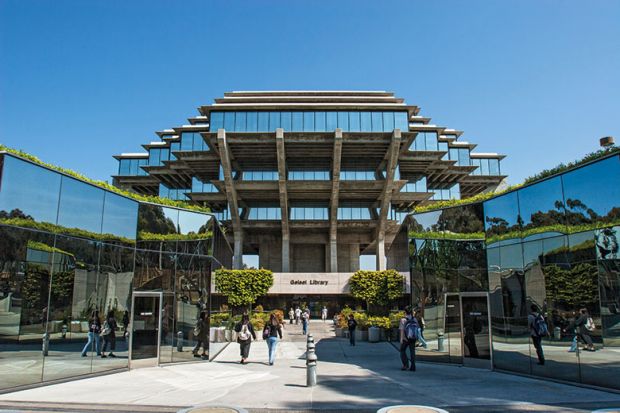Browse the full Times Higher Education World Reputation Rankings 2019 results
The creative energy of California in the mid-20th century not only gave birth to a new medium of entertainment, but also attracted a slew of engineers and scientists to the state. In San Diego, researchers such as Jonas Salk (pictured inset) – who created one of the first successful polio vaccines – opened the Salk Institute, and the Scripps Research Institute (established in 1924) was coming into its own with the addition of Harvard biochemist A. Baird Hastings in 1959, followed by colleagues in immunology, biochemistry and microbiology shortly after. At the same time, the Scripps Institution of Oceanography (established in 1910) was petitioning the University of California’s board of regents to add programmes in engineering and physics to fulfil convergent needs for its oceanographers.
This critical mass of biological and physical scientific thought forged the University of California, San Diego (UC San Diego) in 1960 and laid the foundation for exponential success in a variety of medical, biological, engineering, oceanographic and climate research and innovations.
Today, UC San Diego is recognised as one of the top public research universities in the US and is number one in the Times Higher Education table of the world’s best “Golden Age” universities – institutions that were founded in the aftermath of the Second World War (between 1945 and 1967). While its founding vision has served the institution exceptionally well, at age 60, the university is at a critical point in its history.
An extensive planning exercise undertaken in 2014 yielded UC San Diego’s first-ever strategic plan. Shortly after, the university embarked on an ambitious 10-year, $2 billion (£1.6 billion) fundraising campaign to support strategic initiatives. As of May 2019, we’ve raised 92 per cent of the goal within 70 per cent of the time.
We thought boldly to identify and implement the unprecedented solutions that are necessary to ensure our continued level of excellence and to advance our knowledge in order to address pressing global challenges. Through the planning process, five goals were solidified: enhance the student experience; cultivate a diverse and inclusive university community; nurture and support a collaborative and interdisciplinary research culture; support and promote just and sustainable forms of economic development, shared prosperity, and social and cultural enrichment regionally and globally; and create an agile, sustainable and supportive infrastructure by ensuring a dedication to service, people and financial stewardship.
An analysis of our academic and research strengths, faculty and campus leaders also identified four main research themes: understanding and protecting the planet; enriching human life and society; exploring the basis of human knowledge, learning and creativity; and understanding cultures and addressing disparities in society. These four areas of focus are where UC San Diego has deep and broad expertise and are rich with possibility for creation and innovation, education and training.
We hired more cross-discipline faculty; built new thinktanks, research centres and institutes; and expanded industry partnerships locally, nationally and internationally.
Our efforts to develop more convergent (cross-disciplinary) opportunities are paying off. The Halicioğlu Institute for Data Sciences is developing new methods and infrastructure in the emerging field of data science to help all disciplines solve the planet’s most critical issues. The Microbiome and Microbial Sciences Initiative is creating enabling technology to understand and control the complex microbial communities that underpin processes on scales from our bodies to our planet. And the first phage therapy centre in North America, the Center for Innovative Phage Applications and Therapeutics, is bringing innovative research and clinical practice to the field of medicine. These are just three examples of the many new centres and institutes being established at UC San Diego.
We then turned our attention to smarter growth. Undergraduate applications have nearly doubled since 2012. In response, enrolment has grown by 34 per cent in the same period. Meeting this growth requires not only more investment in faculty, advising and student services, but also the creation of more academic infrastructure and housing. With input from both campus and community, we updated our Long-Term Development Plan and gained approval from the UC regents. Today, construction has started on three new living and learning complexes that will add 4,250 new beds to campus inside vibrant mixed-use “neighbourhoods” incorporating residential, academic, administrative, public, and retail and dining spaces.

The neighbourhoods are scheduled to open in the same year as a $2.1 billion extension of San Diego’s light-rail system, the UC San Diego Blue Line, linking our La Jolla campus with our medical campus in Hillcrest, our new innovation hub under construction in downtown San Diego and the US/Mexico border. Also located downtown, we are in the planning stages of a sister attraction to the Scripps Institution’s Birch Aquarium.
Later this year, we break ground on two more projects to expand collaborative lab, classroom and faculty space. Other planned construction includes a new gateway centre, two more living and learning neighbourhoods, and extensive improvements to public space and campus mobility. By 2035, we will have built 27.8 million gross square feet of academic, research, housing and public-serving facilities and added 15,000 beds, allowing us to offer a four-year housing guarantee to undergraduates and graduates at 20 per cent below market prices.
Between 2012 and 2017, UC San Diego invested $2 billion to create the La Jolla Medical Center, which included significant upgrades to campus infrastructure. With the opening of the Altman Clinical & Translational Research Institute, the Jacobs Medical Center and the Koman Family Outpatient Pavilion, UC San Diego Health now offers the best clinical care and translational medicine in one location. We will soon invest another $2 billion in our Hillcrest Medical Campus.
Beyond the new buildings, an intellectual and cultural transformation is under way that is re-energising the student experience, sparking breakthrough research and innovation, and providing world-class patient care.
With $1.2 billion in annual sponsored research and a growing portfolio of regional, national and global partnerships, the Nature Index ranked UC San Diego seventh in the world for scientific impact. While I’m extremely proud of our success in expanding research impact, there’s one ranking that speaks to our collective efforts as educators. Washington Monthly ranked UC San Diego first in the US for contributions to social mobility, research and public service. This speaks to our very vision to be the nation’s leading student-centred, research-focused, service-oriented public university.
Pradeep K. Khosla is chancellor of the University of California, San Diego.
POSTSCRIPT:
Print headline: A bright outlook
Register to continue
Why register?
- Registration is free and only takes a moment
- Once registered, you can read 3 articles a month
- Sign up for our newsletter
Subscribe
Or subscribe for unlimited access to:
- Unlimited access to news, views, insights & reviews
- Digital editions
- Digital access to THE’s university and college rankings analysis
Already registered or a current subscriber?







